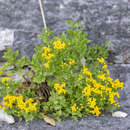Comments
provided by eFloras
A specimen resembling Perityle lindheimeri was collected in 1936 near Ruidosa in Lincoln County, New Mexico. The identity and exact location of that seemingly out-of-place collection remain to be determined.
- license
- cc-by-nc-sa-3.0
- copyright
- Missouri Botanical Garden, 4344 Shaw Boulevard, St. Louis, MO, 63110 USA
Description
provided by eFloras
Perennials or subshrubs, (10–)18–45(–60) cm; glabrate or sparsely hairy. Leaves: petioles 4–15 mm; blades broadly ovate to ovate-lanceolate, 10–40 × 10–35 mm, margins entire or serrate-lobed. Heads in corymbiform arrays, 6–7 × 4–6 mm. Peduncles 3–20 mm. Involucres narrowly campanulate. Phyllaries 12–14, narrowly lanceolate to oblanceolate, 3–4 × 2 mm. Ray florets 3–5; corollas yellow, laminae oblong to suborbiculate, 2.5–3 × 1.5–2 mm. Disc florets 16–22; corollas yellow, tubes 0.8–1.5 mm, throats narrowly campanulate, 1–1.5 mm, lobes 0.5 mm. Cypselae linear-oblong to narrowly oblanceolate, 2–2.8 mm, margins thin-calloused, minutely hairy; pappi 0, or of 1(–2) bristles 0.5–1.8 mm.
- license
- cc-by-nc-sa-3.0
- copyright
- Missouri Botanical Garden, 4344 Shaw Boulevard, St. Louis, MO, 63110 USA
Synonym
provided by eFloras
Laphamia lindheimeri A. Gray, Smithsonian Contr. Knowl. 3(5): 101. 1852; L. rotundata Rydberg; Perityle rotundata (Rydberg) Shinners
- license
- cc-by-nc-sa-3.0
- copyright
- Missouri Botanical Garden, 4344 Shaw Boulevard, St. Louis, MO, 63110 USA
Comprehensive Description
provided by North American Flora
Laphamia rotundata Rydberg, sp. nov
A low perennial with thick woody caudex; stems about 1 dm. high, glandular-puberulent;
leaves mostly alternate; petioles 5-8 mm. long, glandular-puberulent; blades 5-10 mm. long,
rounded-ovate or suborbicular, truncate at the base, coarsely dentate, 3-ribbed. rather firm,
glandularor scabrouspuberulent and impressed-punctate ; heads corymbose; involucre
campanulate, 4 mm. high and about as broad; bracts 10-12, linear-oblanceolate, glabrate;
disk-corollas 3 mm. long; tube shorter than the campanulate-funnelform throat; achenes oblong,
2 mm. long, sparingly and minutely hispidulous; pappus of a single bristle, nearly equaling the
corolla.
Type collected at San Estaban, Texas, September 3, 1852, Bigelow (referred to L. rupestris by Dr. Gray; type in herb. N. Y. Bot. Gard.).
- bibliographic citation
- Per Axel Rydberg. 1914. (CARDUALES); CARDUACEAE; HELENIEAE. North American flora. vol 34(1). New York Botanical Garden, New York, NY
Comprehensive Description
provided by North American Flora
Laphamia lindheimeri A. Gray, PI. Wright. 1: 101. 1852
A perennial with woody caudex; stems erect, 1-2 dm. high, grayish-puberulent ; leaves
mostly alternate; petioles about 1 cm. long; blades ovate to elliptic, entire or sinuate-dentate,
minutely puberulent or glabrate, glandular-punctate, 1-2 cm. long, 3-ribbed; heads corymbose;
involucre 3.5-4 mm. high, 4 mm. broad; bracts 12-14, linear-oblanceolate, ciliate towards
the apex; ligides obovate, 3 mm. long, 3-toothed; disk-coroUas 2 mm. long, the tube equaling
the campanulate throat; achenes oblong, 2 mm. long, minutely hispidulous on the margins;
pappus of a single bristle or rarely wanting.
Type locality: Banks of Guadalupe River, near New Braunfels, Texas. Distribution: Central Texas.
- bibliographic citation
- Per Axel Rydberg. 1914. (CARDUALES); CARDUACEAE; HELENIEAE. North American flora. vol 34(1). New York Botanical Garden, New York, NY
Perityle lindheimeri
provided by wikipedia EN
Perityle lindheimeri, commonly called Lindheimer's rock daisy,[1] is a species of flowering plant in the aster family (Asteraceae). It is native to the United States, where it is endemic to the Edwards Plateau of Texas.[1][2]
Its natural habitat is in crevices of Cretaceous-age limestone rock, often near streams or springs.[1]
Perityle lindheimeri is a perennial subshrub. It produces a yellow inflorescence, with both ray and disk flowers.[1] It blooms from spring through fall.[3]
References

- license
- cc-by-sa-3.0
- copyright
- Wikipedia authors and editors
Perityle lindheimeri: Brief Summary
provided by wikipedia EN
Perityle lindheimeri, commonly called Lindheimer's rock daisy, is a species of flowering plant in the aster family (Asteraceae). It is native to the United States, where it is endemic to the Edwards Plateau of Texas.
Its natural habitat is in crevices of Cretaceous-age limestone rock, often near streams or springs.
Perityle lindheimeri is a perennial subshrub. It produces a yellow inflorescence, with both ray and disk flowers. It blooms from spring through fall.
- license
- cc-by-sa-3.0
- copyright
- Wikipedia authors and editors

